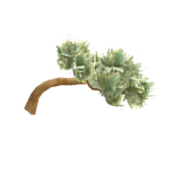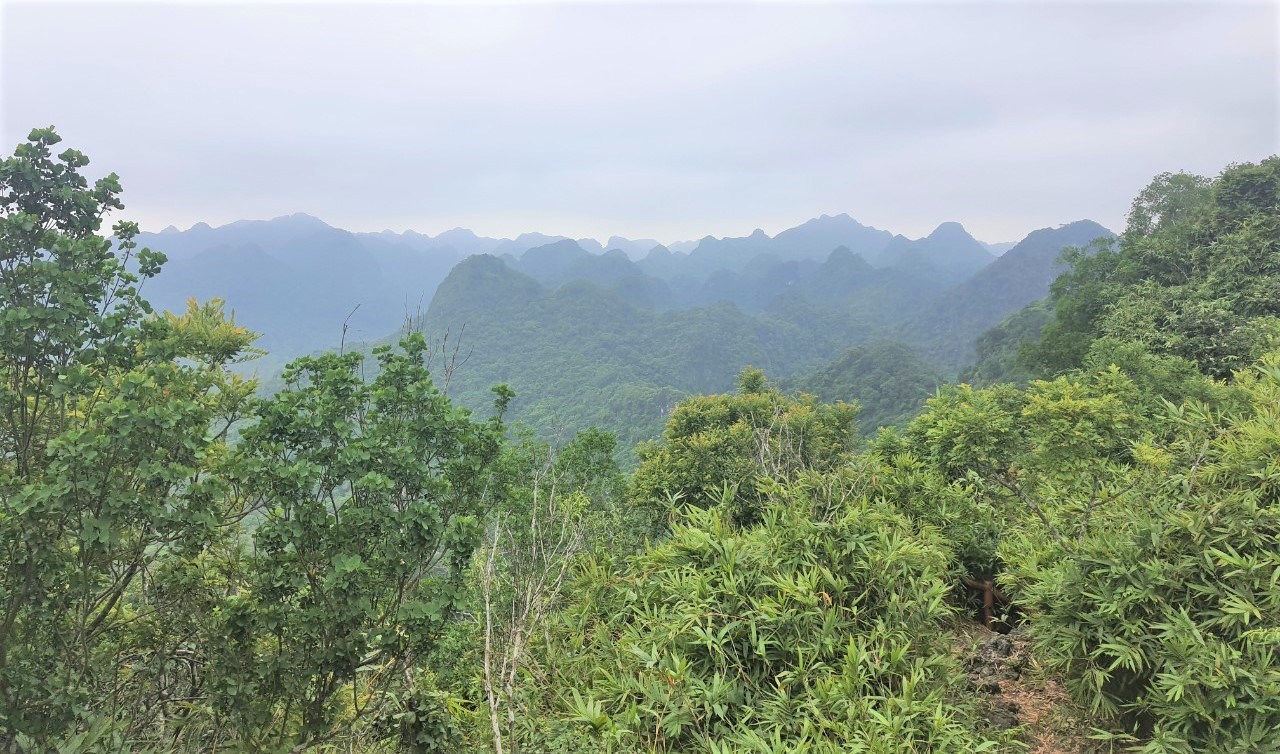Kim Giao forest - Ngu Lam Peak
 Location here
Location here
 The journey to experience this eco-tourist route is about 3km long (both going and returning), the travel time is about 2 - 2.5 hours. This is a tourist route chosen by the majority of visitors when visiting the Park to explore and conquer because this is an eco-tourist route that is not only attractive but also somewhat challenging for those who are determined to challenge exploring and conquer the nature of tourists. It is a great opportunity to learn about the biodiversity of Cat Ba National Park and admire the magnificent scenery, mountains, and messages of the Cat Ba archipelago.
The journey to experience this eco-tourist route is about 3km long (both going and returning), the travel time is about 2 - 2.5 hours. This is a tourist route chosen by the majority of visitors when visiting the Park to explore and conquer because this is an eco-tourist route that is not only attractive but also somewhat challenging for those who are determined to challenge exploring and conquer the nature of tourists. It is a great opportunity to learn about the biodiversity of Cat Ba National Park and admire the magnificent scenery, mountains, and messages of the Cat Ba archipelago.
 Starting from the Garden Center, following the path between the rows of collective houses built by Cat Ba Forest Enterprise in the 60s of the last century, during the period when the North carried out the construction of socialism and aided human strength. In order to fight for the liberation of the South, visitors can admire the botanical garden of the Cat Ba.
Starting from the Garden Center, following the path between the rows of collective houses built by Cat Ba Forest Enterprise in the 60s of the last century, during the period when the North carried out the construction of socialism and aided human strength. In order to fight for the liberation of the South, visitors can admire the botanical garden of the Cat Ba.

 With a total area of about 13.5 hectares, the botanical garden is a miniature model of the forest plant diversity of Cat Ba archipelago. Visitors coming here can feel the diversity of flora on the island. Hundreds of native plant species with many rare and precious genetic resources have been collected and planted here for the purpose of conservation and reserve of rare genetic resources which have been collected and planted here for conservation and reserve genetic resources, serving scientific research, sightseeing tours and propaganda, education and environmental protection.
With a total area of about 13.5 hectares, the botanical garden is a miniature model of the forest plant diversity of Cat Ba archipelago. Visitors coming here can feel the diversity of flora on the island. Hundreds of native plant species with many rare and precious genetic resources have been collected and planted here for the purpose of conservation and reserve of rare genetic resources which have been collected and planted here for conservation and reserve genetic resources, serving scientific research, sightseeing tours and propaganda, education and environmental protection.

 Through the botanical garden, visitors begin to visit and explore the forest ecosystem on limestone mountains, which is the main type of forest ecosystem of the Cat Ba archipelago. If you look closely, you can see the forest here is divided into many layers:
Through the botanical garden, visitors begin to visit and explore the forest ecosystem on limestone mountains, which is the main type of forest ecosystem of the Cat Ba archipelago. If you look closely, you can see the forest here is divided into many layers:
Forest soil layer (rotten carpet): The forest soil layer is the soil layer made up of dead trees, fungi, mosses, ferns, and small plants. Animals that can live here include worms, insects, civets, mink...
- Middle layer and shrubs: above the forest land layer there are several layers of vegetation. There is usually a layer of shrubs, followed by a middle layer of small trees and growing trees. Animals that can live here include insects, frogs, squirrels, birds...etc.
-Elevation: This level includes the foliage and the highest overhangs. The forest canopy is a dense roof of trees standing close to each other. In some places, taller trees rose above the entire floor. Animals living here include Golden Monkey, Langur, Squirrel...etc.
- Non-layer: through the above-mentioned forest layers are climbing plants, vines and epiphytes.


 Kim Giao precious wood forest
Kim Giao precious wood forest
Kim Giao forest area grows into a population of almost pure species, about 10 hectares wide. Kim Giao belongs to a small tree species, straight trunk, flaky bark, cylindrical canopy, thick oval-shaped leaves with spears.
 The tree grows relatively slowly, naturally regenerates well, produces cones (flowers) in March and April (with male and female cones), ripe fruits in September and October, purple in color, fruit diameter 1.5 – 2 cm. Light yellow wood, suitable for making handicrafts. Legend has it that Kim Giao tooth is a precious tree named after Princess Kim Ngan and her consort Ngoc Giao to record the beautiful and tragic love of two people. Kim Giao wood was used by ancient kings to make chopsticks to identify poisonous foods.
The tree grows relatively slowly, naturally regenerates well, produces cones (flowers) in March and April (with male and female cones), ripe fruits in September and October, purple in color, fruit diameter 1.5 – 2 cm. Light yellow wood, suitable for making handicrafts. Legend has it that Kim Giao tooth is a precious tree named after Princess Kim Ngan and her consort Ngoc Giao to record the beautiful and tragic love of two people. Kim Giao wood was used by ancient kings to make chopsticks to identify poisonous foods.

From Kim Giao forest, go about 1km to conquer Ngu Lam peak, after visiting different types of forests such as forests in the valleys and foothills of limestone mountains, forests on limestone slopes, forests on top. If you are lucky and observant, you can come across animals: white-tailed red-bellied squirrel: they have a body length of 20-25 cm and a weight of 250 to 460 grams. The tail is 19-28 cm long. The fur on the head, neck, back and outside of the legs is gray, and the inner belly of the legs is red. Their tail is the same color as the back, but the end of the tail can be white or black.
 This squirrel is independent and active during the day. They live mainly on trees, their food is usually fruits, seeds, flowers, sprouts, and bark. Squirrels make their nests out of small twigs and leaves. Black squirrel: 37 - 46 cm long, 45 - 55 cm long tail. Squirrels of the genus Ratufa are one of the largest order of rodents in the world that live in trees, they can weigh up to 1.5 kg. The black squirrel has a black body coat and only the breast and cheeks are white or pale yellow. They are usually solitary but sometimes live in groups of two or three. They live mainly on forest foliage, where they can easily obtain fruits, seeds and leaves.
This squirrel is independent and active during the day. They live mainly on trees, their food is usually fruits, seeds, flowers, sprouts, and bark. Squirrels make their nests out of small twigs and leaves. Black squirrel: 37 - 46 cm long, 45 - 55 cm long tail. Squirrels of the genus Ratufa are one of the largest order of rodents in the world that live in trees, they can weigh up to 1.5 kg. The black squirrel has a black body coat and only the breast and cheeks are white or pale yellow. They are usually solitary but sometimes live in groups of two or three. They live mainly on forest foliage, where they can easily obtain fruits, seeds and leaves.

To the top of Ngu Lam, with an altitude of 225 m above sea level, visitors will be captivated by the landscape and mountains like green pyramids. From here visitors will have a panoramic view of the central area of Cat Ba, there is also an interesting interpretation of information about the karst topography for visitors in Vietnamese and English.
From here, visitors will observe a great value on the geomorphology of Cat Ba archipelago, which fully converges factors to be recognized as a Global Geopark. Cat Ba is the most typical example in the world of limestone terrain being eroded by the sea. The common positive terrain is limestone mountain ranges with pyramidal tops or solitary tower-shaped limestone mountains


